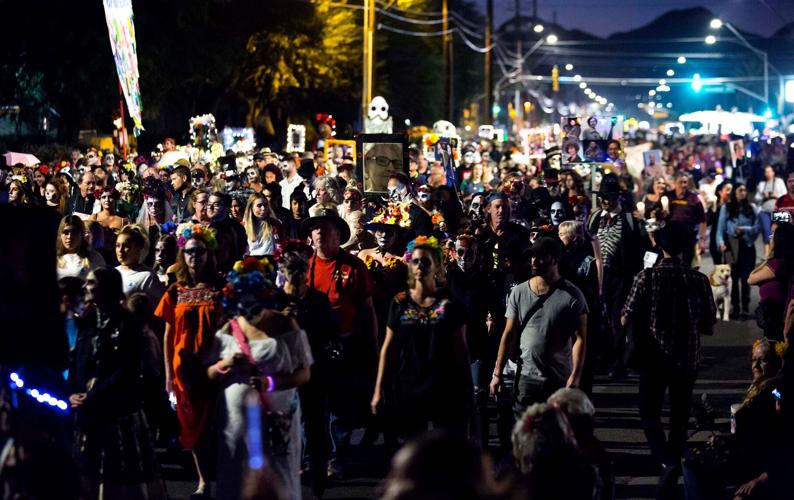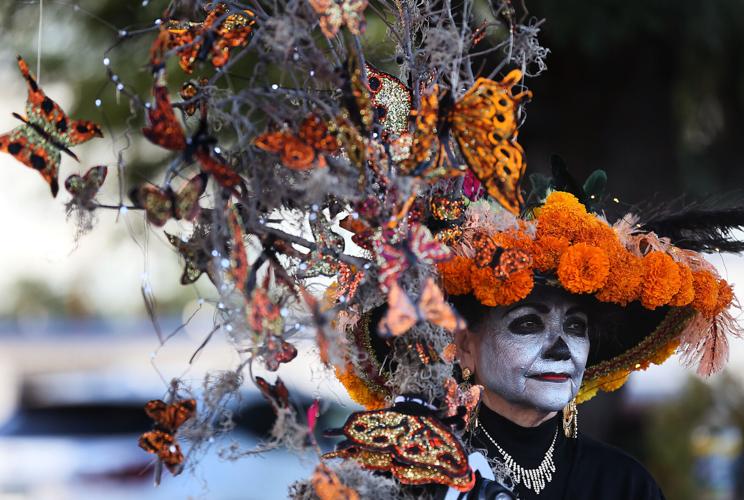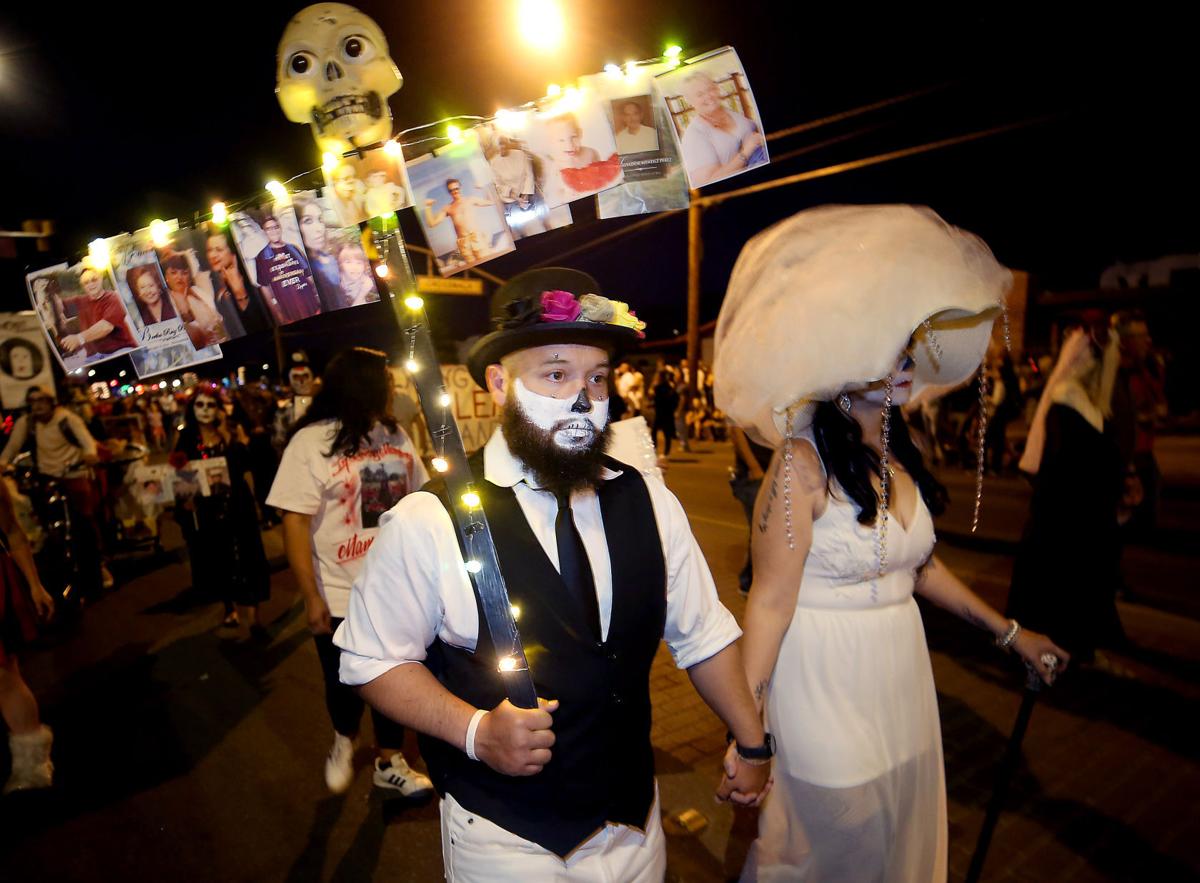An estimated 150,000 people gathered in the streets on Tucson’s west side in 2021 to participate in the collective mourning, honoring and remembering of lost loved ones as part of the annual All Souls Procession.
As the first in-person procession to take place since the start of the COVID-19 pandemic, which at that point in time had killed more than 700,000 Americans, according the Centers for Disease Control and Prevention, the experience was deeper for many participants, said artistic director Nadia Hagen.
“It was more relevant,” Hagen said. “Death was more present in people’s space in a really personal way. It was not this conceptual exercise.”

Messages to loved ones burn in the urn at then end of the 32nd Annual All Souls Procession in Tucson.
Hagen said Many Mouths One Stomach, the collective that puts on the procession, is expecting even higher attendance at this year’s event, set to take place this Sunday, Nov. 6.
Whether you are from the Tucson area, or traveling from afar, here is what you can expect.
The route
As has been the case for the last several years, the All Souls Procession will take place west of Interstate 10, in the Barrio Hollywood and Menlo Park neighborhoods.
Folks will start gathering at about 4 p.m. just south of West Speedway on North Grande Avenue. At about 6 p.m., the procession will begin its journey south, snaking its way down North Grande and North Bonita avenues, along the Santa Cruz river, until finding its way to the Mercado District, south of West Congress.
The All Souls Procession guide on the website recommends bringing comfortable shoes, water and a flashlight. The trek is about two miles long, so if you are not used to walking, maybe find a good parking spot toward the end of the route, to catch the final ceremony.
The Mercado District, and more specifically, the lots near the MSA Annex, 267 Avenida del Convento, will serve as the staging area for the finale — a mix of theatrical and dance performances, live music and elaborate visuals culminating in the burning of a massive urn hoisted high into the sky.
“I love this route,” Hagen said. “I think there is something so special about walking through the barrios. The barrios are the heart of the city. Having that connection to the river, the path that goes along the river and ends at the foot of the mountain that is our namesake. That really resonates.”

People crowd St. Marys Road pre-pandemic at the 2019 30th All Souls Procession in Tucson.
The theme
For this year’s theme, A Sandstorm is a Seedstorm, Hagen was inspired by none other than biologist and natural historian David Attenborough, who filmed an episode of his 2022 BBC documentary series “The Green Planet” in Southern Arizona.
“There was something he said in that episode about within every haboob, there is not just dust, but millions of seeds,” Hagen said.
That one line got Hagen and her team talking about the bigger patterns in life. How things that are destructive, might also be necessary parts of a cycle that in turn create new life, according to the All Souls website.
The website continues: “Beyond resilience is an ability to not just ‘spring back’ but spring forward.”

Benjamin Albert Yanez, left, hugs his girlfriend, Amy Vance during the finale of the 30th All Souls Procession in 2019.
The concerts
While the procession is free to attend, many of the behind-the-scenes aspects that go into putting on such a large-scale event do cost money.
Hagen estimates that, for this year alone, $11,000 will go toward police and another $11,000 will go toward traffic control. Then there are things like trash collection and port-a-potty rentals.
The procession has historically relied on donations, but donations have been down in recent years, Hagen said. Organizers are hoping that several fundraising concerts, dubbed the Dance of the Dead series, will help offset some of the costs.
The series consists of two concerts and an afterparty, all held in the festival area of the MSA Annex. Concert One will take place Friday, Nov. 4, at 6 p.m. and will be headlined by MarchFourth, the marching band with a funk rock attitude from Portland, Oregon. The group has been through Tucson several times and always brings the party. Tickets are $20 in advance through the All Souls website and $25 at the door.
Concert Two, at 5 p.m. on Saturday, Nov. 5, will include performances from First Nations vocalist Shylah Ray Sunshine and multi-instrumentalist world musician, Poranguí, who has also been tapped as the composer for the finale ceremony. Tickets for this concert are also $20 in advance through the website and $25 at the door.
The afterparty happens directly following the procession finale and will feature sets from local Latin-fusion supergroup Santa Pachita and the Casa De Los Muertos DJs. Tickets are $5 in advance on the website and $10 at the door.

Evangelina Dominguez, a participant in the 2021 All Souls Procession, says the butterflies represent the family and friends who have passed.
The future
The procession has taken on seven new directors this year to help steer the event into the future, including a new volunteer coordinator, a new usher director and a new director for the Procession of Little Angels, a separate walk for children that will take place from 3 to 7 p.m. on Nov. 5 at Armory Park, 221 S. Sixth Ave., downtown.
“Almost all of the new directors are women,” Hagen said. “All of them are in their early 30s. It is a generational shift, which is huge.”
Hagen said Many Mouths One Stomach started putting out feelers for new directors during the pandemic.
“It is our intention for the event to have a legacy,” Hagen said. “The way to have legacy is to mentor. To hand off the responsibility and the information; the wisdom that we gain in doing this over the years so the next generation can be empowered to take that on. Otherwise, there is no legacy or future.”
Hagen said after 32 years, the annual event continues to grow.
“When it was first starting, it was like a baby and couldn’t walk,” Hagen said. “It was a wild, unruly teenager for a while.
“Now, we are a young adult. We’ve got some things figured out. We probably still need to call home and ask for money every now and again, but we know where our limbs are, how our hands work, what we like. We’ve learned some things.”










